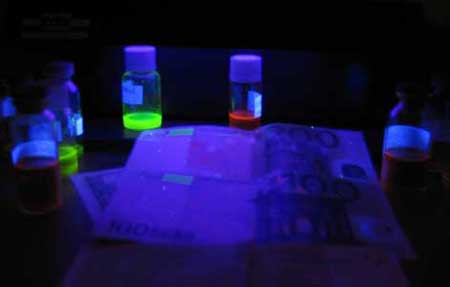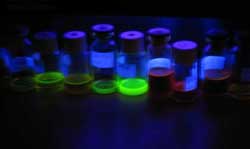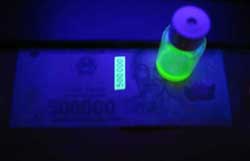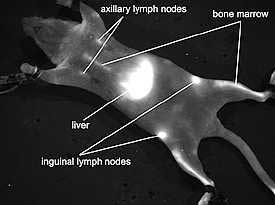With sizes of just a few nanometers, quantum dots developed by Vietnamese scientists have significant potential applications in security and biological research.
 |
|
Under ultraviolet light, the quantum dots can be seen emitting various colors on a euro coin. Surrounding them are jars containing quantum dots emitting corresponding colors created by the Institute of Materials Science. |
Quantum dots (quantum dot) are essentially semiconductor crystals with diameters of just a few nanometers (one nanometer is one billionth of a meter). Although they are made of the same material, quantum dots of different sizes will emit different colors under infrared or ultraviolet light.
Taking advantage of this property, many countries around the world have utilized quantum dots to mark goods, documents, or banknotes to prevent counterfeiting, and to inject quantum dots into animal bodies for observation and imaging of organs and cells. Furthermore, quantum dots have the potential to be used in cancer detection and targeted drug delivery to cancer cells…
Recognizing the benefits of quantum dots, researchers at the Institute of Materials Science began studying and creating these dots five years ago. This research is quite bold considering Vietnam lacks the microelectronics technology and expensive machinery used in developed countries to create quantum dots through physical methods.
Despite these challenges, the group has achieved encouraging results. Specifically, they have produced CdSe (Cadmium Selenide) quantum dots with sizes ranging from 3.2-3.7nm and CdS (Cadmium Sulfide) quantum dots measuring 2.6-3.2nm. According to Associate Professor Dr. Pham Thu Nga, a member of the group, they utilized chemical methods to create these dots. This is a very powerful and cost-effective tool for producing quantum dots of desired sizes, which is particularly suitable for developing countries.
Not stopping there, the research team also successfully created SiO2 microspheres using chemical methods. With sizes ranging from several tens to several hundred nanometers, SiO2 is not a semiconductor and therefore does not fluoresce like quantum dots. It is engineered to carry quantum dots into cells, enhancing cellular imaging. In simple terms, one can imagine the microspheres as balls with the quantum dots resembling small beads attached around them.
According to Dr. Nga, for applications such as these in Vietnam, it is essential to produce quantum dots and SiO2 microspheres in large quantities. This is the future plan of the research group. Producing quantum dots and SiO2 microspheres through chemical methods in Vietnam will significantly reduce costs compared to similar products from abroad. It is reported that 100ml of quantum dots used for marking biological cells produced by Quantum Dot Company in the U.S. costs $600.
|
|
Additional Potential Applications of Quantum Dots |
|
Recently, chemists from Vanderbilt University (USA) accidentally discovered a way to make quantum dots emit white light. With this discovery, quantum dots may be used in the future to create light-emitting diodes (LEDs), replacing the current incandescent bulbs. The U.S. Department of Energy estimates that LED lighting will help reduce lighting energy consumption in the U.S. by 29% by 2025, saving households $125 million. Quantum dots may also serve as materials for producing optical switches. A single quantum dot can function as a tiny electronic unit, such as a transistor, forming the basis for nano-sized electronic devices. With sizes ranging from 1-6nm, billions of quantum dots can fit on the head of a pin. |
Minh Sơn























































